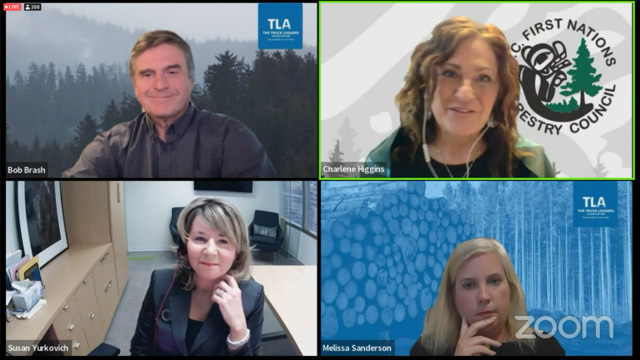
Bob Brash, Charlene Higgins, Susan Yurkovich and Melissa Sanderson
Delving deeper into the merits of the specifics, was the second TLA session focused on perspectives related to Modernizing Forest Policy in BC. And first up was Melissa Sanderson, ADM, Forest Policy and Indigenous Relations, BC Ministry of Forests, who described the government’s vision for the modernizing of BC’s forest policies. The current context being the challenging circumstances, that forests are foundational to BC’s economy, that serious threats and challenges are being faced, and that the current policy framework is inadequate to address today’s challenges. According to Sanderson, “the efforts to shift forest policy were driven by the goals of meaningful action on reconciliation with First Nations, increase inclusivity for communities, a competitive industry, fair returns to the Crown and increased efforts on sustainability and stewardship. According to Sanderson, the Intentions Paper was “greatly informed by engagements that have taken place in the past, notwithstanding the challenge of overlapping crises [covid, fires and floods], and that the engagement will be ongoing”.
With respect to the new tools required to implement the changes, Sanderson noted the progress made with forest worker successorship protections and the amendments to the timber harvesting contract and sub-contract regulations. Sanderson highlighted the key elements of Bill 23 related to FRPA (repositioning government as the land manager, reasserting the public interest in forest management, and requiring landscape level plans in collaboration with First Nations). With respect to Bill 28, Sanderson said, “the compensation framework will address certainty on what is compensable and how it is to be valued”.
Next up, Charlene Higgins, CEO of the BC First Nations Forestry Council, described what she’s been hearing from First Nations related to the province’s modernization policies as “one of frustration… and that frustration is growing”. According to Higgins, this is because:
- The polices were developed internally with no First Nations involvement.
- The engagement processes were limited, poorly timed and incompatible with how First Nations engage.
- The feedback sought was highly technical and many First Nations lack the expertise, capacity and resources to respond meaningfully.
- The proposed changes do not advance the priority areas of work identified in the BC First Nations Forest Strategy, which was developed in concert with the BC government. Rather, the modernization policies represent the priorities of government.
Given government’s alignment with many of the First Nations Forestry Strategy goals, such as shared governance, forest policy reform, improving First Nations role, Higgins described the government’s effort as a “missed opportunity”. In addition, First Nations are seeking joint decision making and meaningful revenue sharing. As such, Higgins is seeking a full reset on the engagement process. …She concluded by saying, “the public wants a different approach to the use of BC’s forests with real collaboration with First Nations regarding the use and management of forest land and resources.” And “First Nations involvement in the sector as full partners is the new paradigm that will create the climate for investment needed to support a thriving forest sector.”
The final speaker, Susan Yurkovich, President and CEO of the BC Council of Forest Industries, started by noting “the importance of this conversation because of breadth and depth the industry has on the economic and social fabric of the province.” An importance that was “underscored by recent research by the Business Council of BC on how the province led the pack coming out of the economic downturn due to the pandemic.” Examples provided by Yurkovich include:
- $13 billion in GDP, 100,000 jobs, $8 billion in wages and $4 billion in revenue to gov’t
- Supporting 1 in 25 BC jobs and more than 5,300 indigenous employed
- $7 billion in goods and services purchased from 9,900 suppliers in 340 communities
- $14 billion in capital investments in BC plants and equipment over 10 years
- BC is already a leader in conservation, 52% of land base has conservation measures on it
From industry’s perspective, the modernization of BC’s forest policy must:
- Start with a fact-based, balanced, and inclusive approach (agreed set of facts and then look at balancing the values).
- Needs an inclusive group of people having these conversations (meaning everyone is at the table).
- Have Indigenous Nations as full partners (with a say and meaningful revenue sharing)
- Champion BC’s low-carbon forest products as part of the climate solution (a strong message for investors)
“But”, says Yurkovich, “predictable access to fibre at a reasonable cost is the key for all participants, regardless of size. No-one will invest in new mills, or retool, or increase their value-added production without assurance of fibre access. And for industry, that includes clear rules and transparency and timely processes to plan for the future. We have to have policy choices that are going to create predictability to encourage innovation and reinvestment.” Yurkovich also noted that “there are a lot of challenges but also a lot of opportunities. BC has great people, great fibre, and the expertise, knowhow and technology to capitalize on the opportunity to be the preferred supplier of low-carbon, sustainable management forest products that will fight climate change. But we have to get it right, and we can’t get it right if we aren’t all working together.”
Photo courtesy of COFI via Twitter